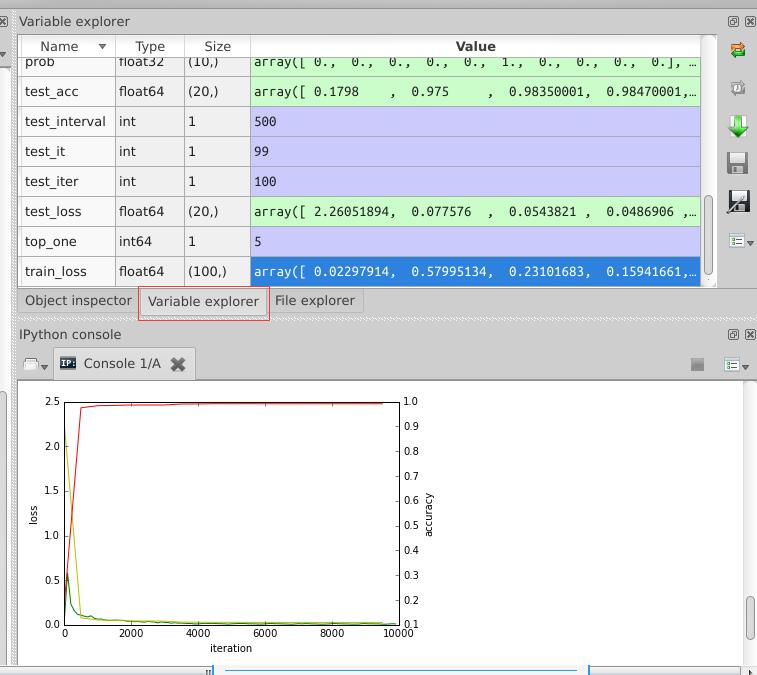Caffe——Python接口学习:绘制loss和accuracy曲线
来源:互联网 发布:mac tomcat端口被占用 编辑:程序博客网 时间:2024/06/07 17:18
Caffe——python接口学习:绘制loss和accuracy曲线
使用python接口来运行caffe程序,主要的原因是python非常容易可视化。所以不推荐大家在命令行下面运行python程序。如果非要在命令行下面运行,还不如直接用 c++算了。推荐使用jupyter notebook,spyder等工具来运行python代码,这样才和它的可视化完美结合起来。因为我是用anaconda来安装一系列python第三方库的,所以我使用的是spyder,与matlab界面类似的一款编辑器,在运行过程中,可以查看各变量的值,便于理解,如下图:
只要安装了anaconda,运行方式也非常方便,直接在终端输入spyder命令就可以了。在caffe的训练过程中,我们如果想知道某个阶段的loss值和accuracy值,并用图表画出来,用python接口就对了。# -*- coding: utf-8 -*-"""Created on Tue Jul 19 16:22:22 2016@author: root"""import matplotlib.pyplot as plt import caffe caffe.set_device(0) caffe.set_mode_gpu() # 使用SGDSolver,即随机梯度下降算法 solver = caffe.SGDSolver('/home/xxx/mnist/solver.prototxt') # 等价于solver文件中的max_iter,即最大解算次数 niter = 9380 # 每隔100次收集一次数据 display= 100 # 每次测试进行100次解算,10000/100 test_iter = 100 # 每500次训练进行一次测试(100次解算),60000/64 test_interval =938 #初始化 train_loss = zeros(ceil(niter * 1.0 / display)) test_loss = zeros(ceil(niter * 1.0 / test_interval)) test_acc = zeros(ceil(niter * 1.0 / test_interval)) # iteration 0,不计入 solver.step(1) # 辅助变量 _train_loss = 0; _test_loss = 0; _accuracy = 0 # 进行解算 for it in range(niter): # 进行一次解算 solver.step(1) # 每迭代一次,训练batch_size张图片 _train_loss += solver.net.blobs['SoftmaxWithLoss1'].data if it % display == 0: # 计算平均train loss train_loss[it // display] = _train_loss / display _train_loss = 0 if it % test_interval == 0: for test_it in range(test_iter): # 进行一次测试 solver.test_nets[0].forward() # 计算test loss _test_loss += solver.test_nets[0].blobs['SoftmaxWithLoss1'].data # 计算test accuracy _accuracy += solver.test_nets[0].blobs['Accuracy1'].data # 计算平均test loss test_loss[it / test_interval] = _test_loss / test_iter # 计算平均test accuracy test_acc[it / test_interval] = _accuracy / test_iter _test_loss = 0 _accuracy = 0 # 绘制train loss、test loss和accuracy曲线 print '\nplot the train loss and test accuracy\n' _, ax1 = plt.subplots() ax2 = ax1.twinx() # train loss -> 绿色 ax1.plot(display * arange(len(train_loss)), train_loss, 'g') # test loss -> 黄色 ax1.plot(test_interval * arange(len(test_loss)), test_loss, 'y') # test accuracy -> 红色 ax2.plot(test_interval * arange(len(test_acc)), test_acc, 'r') ax1.set_xlabel('iteration') ax1.set_ylabel('loss') ax2.set_ylabel('accuracy') plt.show() 阅读全文
0 0
- Caffe——Python接口学习:绘制loss和accuracy曲线
- caffe的python接口:绘制loss和accuracy曲线
- Caffe学习:绘制loss和accuracy曲线(使用caffe的python接口)
- caffe的python接口学习(7):绘制loss和accuracy曲线
- caffe的python接口学习(7):绘制loss和accuracy曲线
- caffe的python接口学习(7):绘制loss和accuracy曲线
- Caffe——绘制loss和accuracy曲线
- Caffe学习系列(19): 绘制loss和accuracy曲线
- Caffe学习系列(19): 绘制loss和accuracy曲线
- Caffe学习系列: 绘制loss和accuracy曲线
- Caffe学习系列(19): 绘制loss和accuracy曲线
- Caffe学习系列(19): 绘制loss和accuracy曲线
- caffe 绘制accuracy和loss曲线
- caffe绘制loss和accuracy曲线
- caffe 绘制loss/ accuracy曲线
- caffe绘制loss,accuracy曲线
- caffe 利用python绘制loss曲线以及accuracy曲线
- caffe学习 绘制loss和accuracy
- Java: 对象的初始化过程
- leetcode 303. Range Sum Query
- 2 认识java虚拟机的基本结构
- StringBuffer的用法
- get请求与post提交区别的简易理解
- Caffe——Python接口学习:绘制loss和accuracy曲线
- 3 常用java虚拟机参数
- 之江学院第0届校赛决赛 A-qwb与支教(容斥+二分)
- np.where函数
- HTTP中GET与POST方法有什么区别
- 仿支付宝支付键盘
- arm函数调用和返回过程详解
- 4 垃圾回收概念与算法
- js实现倒计时


